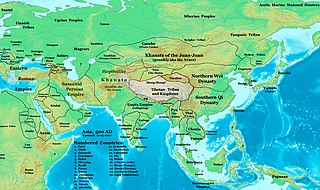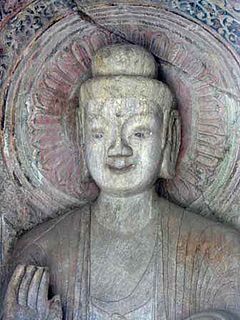
The Three Kingdoms was the tripartite division of China between the states of Wei, Shu, and Wu. It started with the end of the Han dynasty and was followed by the Jin dynasty. The term "Three Kingdoms" is something of a misnomer, since each state was eventually headed not by a king, but by an emperor who claimed suzerainty over all China. Nevertheless, the term "Three Kingdoms" has become standard among English-speaking sinologists. To distinguish the three states from other historical Chinese states of the same names, historians have added a relevant character to the state's original name: the state that called itself Wei (魏) is also known as Cao Wei (曹魏), the state that called itself Han (漢) is also known as Shu Han (蜀漢) or just Shu (蜀), and the state that called itself Wu (吳) is also known as Eastern Wu or Sun Wu (孫吳).

The Northern and Southern dynasties was a period in the history of China that lasted from 420 to 589, following the tumultuous era of the Sixteen Kingdoms and the Wu Hu states. It is sometimes considered as the latter part of a longer period known as the Six Dynasties. Though an age of civil war and political chaos, it was also a time of flourishing arts and culture, advancement in technology, and the spread of Mahayana Buddhism and Daoism. The period saw large-scale migration of Han Chinese to the lands south of the Yangtze. The period came to an end with the unification of all of China proper by Emperor Wen of the Sui Dynasty.

Wuchang forms part of the urban core of and is one of 13 districts of Wuhan, the capital of Hubei Province, China. It is the oldest of the three cities that merged into modern-day Wuhan, and stood on the right (southeastern) bank of the Yangtze River, opposite the mouth of the Han River. The two other cities, Hanyang and Hankou, were on the left (northwestern) bank, separated from each other by the Han.

The Mogao Caves, also known as the Thousand Buddha Grottoes or Caves of the Thousand Buddhas, form a system of 492 temples 25 km (16 mi) southeast of the center of Dunhuang, an oasis located at a religious and cultural crossroads on the Silk Road, in Gansu province, China. The caves may also be known as the Dunhuang Caves; however, this term is also used as a collective term to include other Buddhist cave sites in and around the Dunhuang area, such as the Western Thousand Buddha Caves, Eastern Thousand Buddha Caves, Yulin Caves, and Five Temple Caves. The caves contain some of the finest examples of Buddhist art spanning a period of 1,000 years. The first caves were dug out in AD 366 as places of Buddhist meditation and worship. The Mogao Caves are the best known of the Chinese Buddhist grottoes and, along with Longmen Grottoes and Yungang Grottoes, are one of the three famous ancient Buddhist sculptural sites of China.

The Southern Qi (479-502) was the second of the Southern dynasties in China, followed by the Liang Dynasty. During its 23-year history, the dynasty was largely filled with instability, as after the death of the capable Emperor Gao and Emperor Wu, Emperor Wu's grandson Xiao Zhaoye was assassinated by Emperor Wu's intelligent but cruel and suspicious cousin Xiao Luan, who took over as Emperor Ming, and proceeded to carry out massive executions of Emperor Gao's and Emperor Wu's sons and grandsons, as well as officials whom he suspected of plotting against him. The arbitrariness of these executions was exacerbated after Emperor Ming was succeeded by his son Xiao Baojuan, whose actions drew multiple rebellions, the last of which, by the general Xiao Yan led to Southern Qi's fall and succession by Xiao Yan's Liang Dynasty.

The Longmen Grottoes or Longmen Caves are some of the finest examples of Chinese Buddhist art. Housing tens of thousands of statues of Buddha and his disciples, they are located 12 kilometres (7.5 mi) south of present-day Luoyang in Henan province, China. The images, many once painted, were carved as outside rock reliefs and inside artificial caves excavated from the limestone cliffs of the Xiangshan (香山) and Longmenshan, running east and west. The Yi River flows northward between them and the area used to be called Yique. The alternative name of "Dragon's Gate Grottoes" derives from the resemblance of the two hills that check the flow of the Yi River to the typical "Chinese gate towers" that once marked the entrance to Luoyang from the south. There are as many as 100,000 statues within the 2,345 caves, ranging from 1 inch (25 mm) to 57 feet (17 m) in height. The area also contains nearly 2,500 stelae and inscriptions, hence the name “Forest of Ancient Stelae", as well as over sixty Buddhist pagodas. Situated in a scenic natural environment, the caves were dug from a 1 kilometre (0.62 mi) stretch of cliff running along both banks of the river. 30% date from the Northern Wei and 60% from the Tang dynasty, caves from other periods accounting for less than 10% of the total. Starting with the Northern Wei Dynasty in 493 AD, patrons and donors included emperors, Wu Zetian, members of the royal family, other rich families, generals, and religious groups.

The Yungang Grottoes, formerly the Wuzhoushan Grottoes, are ancient Chinese Buddhist temple grottoes near the city of Datong in the province of Shanxi. They are excellent examples of rock-cut architecture and one of the three most famous ancient Buddhist sculptural sites of China. The others are Longmen and Mogao.

The Hidden Stream Temple Cave is cave number 20 at the Longmen Grottoes near Luoyang, Henan, China.

Junshan Island is an island in Hunan province in China on Dongting Lake. The name means Princesses' Island, and derives from the legend of the Xiang River goddesses. It is only 0.96-square-kilometre (0.37 sq mi) in width. It was formerly a Daoist retreat.

The Maijishan Grottoes, formerly romanized as Maichishan, are a series of 194 caves cut in the side of the hill of Majishan in Tianshui, Gansu Province, northwest China.
Luobi Cave is a karst cave under the west face of Yin Ridge (印岭) located 7 km (4.3 mi) north east of Lizhigou Town (荔枝沟镇), 15 km (9.3 mi) from Sanya City, Hainan Province, People's Republic of China.

The Macaque Cave is a karst cave located on the Macaque Ridge (猕猴岭) outside Dongfang City, Hainan, People's Republic of China.

Taiji Cave is a karst cave located on Shilong Mountain (石龙山) in Guangde County, Xuancheng City, Anhui Province, People's Republic of China, where the provinces of Jiangsu, Zhejiang and Anhui meet. Ming Dynasty writer and poet Feng Menglong described the cave as one of the "Four Absolutes Under Heaven". It is also considered a primary "Place of Enlightenment" by Taoists, similar to the Bodhimanda of Buddhism. The 200-million-year-old cave is divided into dry and wet layers representing the yin and yang of Chinese philosophy.
In February 2004, the Chinese State Council included the cave on its fifth list of National Scenic Attractions. It is also a 4A rated National Tourism Area.
Jingzhou or Jing Province was one of the Nine Provinces of ancient China referenced in Chinese historical texts such as the Tribute of Yu, Erya and Rites of Zhou. It became an administrative division during the reign of Emperor Wu in the Western Han dynasty.

The Western Thousand Buddha Caves is a Buddhist cave temple site in Dunhuang, Gansu Province, China. The site is located approximately 35 km southwest of the urban centre and about the same distance from the Yangguan Pass; the area served as a staging post for travellers on the Silk Road. It is the western counterpart of the Mogao Caves, also known as the "Caves of the Thousand Buddhas" after the founding monk Yuezun's vision in 366 of "golden radiance in the form of a thousand Buddhas". The caves were excavated from the cliff that runs along the north bank of the Dang River. A number have been lost to floods and collapse; some forty are still extant. Twenty-two decorated caves house 34 polychrome statues and 800 m2 of wall paintings, dating from the Northern Wei to the late-Yuan and early-Ming Dynasties. The site was included within the 1961 designation of the Mogao Caves as a Major National Historical and Cultural Site.
Guanyindong or Guanyin Cave is a Palaeolithic cave site, discovered in 1964 in Qianxi County, Guizhou, China.





















